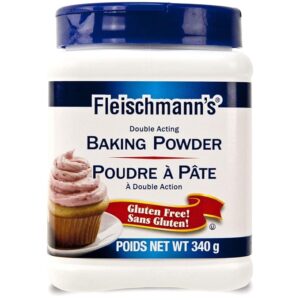Why Double Acting Baking Powder Enhances Sinless Sourdough
Leavening Properties
While SAF Instant Dry Yeast is highly effective for leavening Sinless Sourdough on its own, adding 2 teaspoons of double acting baking powder can enhance oven-spring.
How It Works
SAF Instant Dry Yeast works by metabolizing sugars in the dough, producing carbon dioxide gas that causes the dough to rise, while double acting baking powder acts as a chemical leavening agent, generating additional CO2 through an acid-base reaction when moisture is introduced.
Benefits
Incorporating double acting baking powder can provide benefits such as enhanced oven spring, resulting in a greater rise during the initial stages of baking, and a lighter texture due to the extra gas bubbles created.
Safety Net
Additionally, it serves as a safeguard against under-proofing; if the yeast hasn’t produced enough gas, baking powder can help compensate.
Type Recommendation
Double-acting baking powder is preferable, as it releases some gas at room temperature and more when heated. Hunt for one with zero carbs.
Personal Experience
I see more oven-spring using 2 teaspoons per recipe.


Fleischmann’s and Bob’s Red Mill Double Acting Baking Powder Amazon Links:
Why Does Double Acting Baking Powder Enhance Sinless Sourdough?
Historical Significance
Baking powder was developed in the mid-19th century as a convenient leavening agent. It revolutionized baking by providing a reliable, consistent way to make baked goods rise without yeast or whipped egg whites.
Composition
Baking powder typically consists of:
- A base of sodium bicarbonate (baking soda)
- Slow-acting acid that reacts when exposed to heat, such as sodium aluminum sulfate (SAS)
- A moisture-absorbing agent (usually cornstarch)
Type
There are two main types of baking powder:
- Single-acting: Reacts when moistened
- Double-acting: Reacts twice – once when moistened and again when heated
Nutritional Value
Double acting baking powder is primarily used as a leavening agent in baking and has minimal nutritional value. A typical 1 teaspoon (4g) serving contains about 5 calories, all of which come from carbohydrates. It provides no significant amounts of fat, protein, vitamins, or minerals, with the exception of sodium. The sodium content is relatively high, with one teaspoon containing approximately 590mg, which is about 26% of the recommended daily value. Double acting baking powder also contains small amounts of calcium, contributing about 4% of the daily value per teaspoon. It’s important to note that baking powder is used in small quantities in recipes, so its overall nutritional impact on a finished baked good is generally negligible.
Carb Count
Carbohydrate Content in Double Acting Baking Powder:
Double acting baking powder generally has a very low carbohydrate content, but there can be slight variations between brands. The carbohydrate content in baking powder is typically negligible, especially given the small quantities used in recipes.
Brand Variations:
There are brands that have zero carbs. You have to hunt for them. Bob’s Red Mill double acting baking powder as an example. It stands out as having the lowest carbohydrate content, with effectively zero carbs per serving. According to the nutritional information provided, a 1 teaspoon (4g) serving of Bob’s Red Mill double acting baking powder contains only 1g of total carbohydrates, which is negligible in terms of daily intake. Other brands may have slightly higher carbohydrate counts, but the difference is typically minimal.
Baking Properties
Baking powder has unique baking characteristics:
- Produces carbon dioxide gas when moistened and/or heated, causing baked goods to rise
- Provides a lighter, fluffier texture to baked products
- Works quickly compared to yeast leavening
- Doesn’t contribute significant flavour to baked goods
Contributions to Baking
- Leavening: Causes baked goods to rise without the need for yeast or fermentation
- Texture: Creates a lighter, more open crumb structure
- Convenience: Allows for quick breads and cakes without lengthy rising times
- Consistency: Provides reliable leavening action across various recipes
Use in Traditional Recipes
- Commonly used in low carb quick breads, cakes, biscuits, and pancakes
- Typically used at a rate of 1 to 2 teaspoons per cup of flour
- Often combined with baking soda in recipes containing acidic ingredients
Use in Sinless Sourdough
Baking powder is not typically used in traditional sourdough recipes, as sourdough relies on natural fermentation for leavening. However, it might be used in:
- Hybrid recipes combining sourdough and quick bread techniques
- Recipes aiming for a lighter texture in sourdough-based quick breads
Storage and Shelf Life
- Should be stored in a cool, dry place
- Has a shelf life of about 6-12 months once opened
- Can be tested for effectiveness by mixing with warm water (should fizz vigorously if still active)
